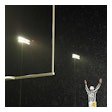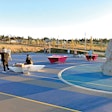![[Photos courtesy of LPA Sport + Recreation]](https://img.athleticbusiness.com/files/base/abmedia/all/image/2019/09/ab.Spotlight919_feat.png?auto=format%2Ccompress&q=70&w=400)
Expectations were high when Southern California's El Camino College Athletic Education and Fitness Complex opened in 2016. The newly built Murdock Stadium's sparkling synthetic turf upended a nearly 60-year tradition of natural grass, and many wondered whether it would successfully serve the day-to-day needs of athletes and community members.
 Arash Izadi is director of LPA Sport + Recreation.
Arash Izadi is director of LPA Sport + Recreation.
At the ribbon-cutting ceremony, all eyes turned to Carol C. Murdock, 84, an alumnus of the community college and a family member of the college's founding president and the stadium's namesake. Carol was there in 1958 at the opening of the original stadium. So what did she think?
"This facility is absolutely phenomenal," she said. "They should have the Olympics here. It has everything they need."
Use case
The planning process began when the community college, which serves more than 500,000 residents in the South Bay region of Los Angeles County, reached out to LPA about an athletics complex, which they hoped would feature a tri-sport stadium that could handle football, soccer and track.
After the college hired us, we got started by listening. This is an important part of the process for both sides. A firm should never come in and tell the client what they need. They should ask questions: Who are you serving? Athletes only? What about community uses — event rentals and weekend athletic activities such as jogging on the track and playing on the fields? It's also important to understand which sports are involved — football, soccer, baseball, track and field? Rugby and lacrosse? What are your concerns about safety? What are your performance targets for the facility?
We knew the facility needed to meet the criteria for football. What we didn't know was whether there were other programs and sports that would be using the field, or what their priority would be in relation to football. Extensive community use was a primary consideration, which drove us to provide a secondary field and jogging track outside the actual stadium. This minimized the need for users to get onto the actual stadium field and solved many security and scheduling issues.
RELATED: Purchasing Guide: Outdoor Tracks
After our initial information gathering was completed, it was clear that El Camino College, named after the famous road that links California's missions, needed an athletics upgrade. The stadium field was ragged, the track looked like it belonged in a junior high school — and extensive use by students and the community threatened to make things worse. The old stadium was so run down that renovation wasn't an option, and programmatically the "bowl" wasn't needed, as there are simply better ways to design stadiums from a sightline standpoint.
College administrators wanted to build a university-quality stadium with a track and field that could handle extensive use, reduce maintenance as much as possible, and meet the competitive needs of their sports programs, all while accommodating community needs. The discussion quickly turned to synthetic turf. Because each project is unique, we try to not to push clients to a choice. However, we think it's important to understand that, based on use and their ability to balance program and maintenance, if clients don't consider synthetic now, they will probably be having the same discussion again in a couple years.
 A secondary field outside the stadium solves a number of security and scheduling issues.
A secondary field outside the stadium solves a number of security and scheduling issues.
Turf selection
There are many benefits to synthetic turf, but the most important aspects are reduced maintenance and consistent play surface. Synthetic turf doesn't need extensive, expensive and complicated care. Regardless of use, grass has to be watered, mowed, fertilized and aerated. Synthetic turf requires minimal maintenance, and it's almost exclusively based on use. It doesn't go dormant like grass, you don't have to overseed it or transition between cool- and warm-season grasses, and it doesn't become a muddy mess when it rains.
Choosing the right synthetic turf requires a deep analysis of the facility's goals. What kind of fiber will be in your turf? How tall will the fibers be? What infill will go between the fibers — will it be mainly rubber and sand or a mix of products? What about a shock pad to reduce the potential for injuries?
The design process should include an analysis of the sports played on the field, as each has its specific needs. When a 300-pound lineman is running on a field, it's all about foot planting, traction and wear. Ball roll isn't as important, because you're not asking the ball to roll. The only time it bounces is during a kickoff, a punt or a fumble. But soccer is the complete opposite, as it's all about ball roll. Durability is key for rugby and lacrosse, which by their nature can really tear up fields. Baseball is its own unique animal, with special turf needs for various parts of the field.
RELATED: Find more solutions for your facility in the Buyers Guide
When it comes to fiber, one option is monofilaments, which are like hair plugs, each individually plugged in and intended to stay vertical. Monofilament acts more like natural grass, which is good for ball roll. There is also a slit film, which can resemble a ribbon and is designed to fibrillate. Today's slit films can withstand greater wear and tear. A thatch layer, which is designed to mimic thatch in natural turf, is another option.
Based on the priorities identified at El Camino, we decided on a 2.5-inch monofilament fiber with a sand-rubber infill mix. This was a good compromise to provide a safe, durable field that would serve both football and soccer players. By comparison, at one of our later projects, a slightly bigger stadium at nearby Cerritos College, we went with a 2.25-inch monofilament fiber with rubber and sand infill and a shock pad, in part due to the growing concern about concussions in sports.
Player safety is really the biggest concern in the design of athletics facilities right now. Just like shock absorbers, shock pads attenuate impact. Rubber and sand are typical infills within the fibers, but expectations are changing because of safety and health concerns. Organic infill is very popular these days, especially in California, and not just because of environmental concerns. Black rubber gets really hot, and using an organic infill like cork, coconut husk or olive core, to name a few, can lower field temperatures by as much as 30 degrees, depending on environmental conditions.
For El Camino, the 2.5-inch system offers an appropriate amount of fiber and allows for more infill to help attenuate shock and maintain Gmax criteria. The system that was used is also a heavyweight system that increases the amount of sand and balances the amount of fiber and infill.
 Eliminating the old stadium bowl improved sightlines for spectators.
Eliminating the old stadium bowl improved sightlines for spectators.
Procurement and construction
The procurement process for El Camino involved a strategy that's similar to "piggyback procurement." In this case, every aspect was put out to bid through a standard design-bid-build process, but the actual turf carpet and track surfacing was procured through the California Multiple Awards Schedule (CMAS), which allowed the college to get the exact product it had selected, including the track and turf specifically. The school also benefitted from the larger bid process for the expensive portions of the project, such as the grading, drainage, base material and asphalt.
For synthetic track and field projects like El Camino, it's also important to give a lot of time and attention to the construction process. Although the materials are fairly standard, these kinds of projects depend on precision and expert craftsmanship. Contractors with experience in track and field projects are a necessity. For example, if the gradation of the rock under the field is off by a few percentage points, or if the material is over- or under-compacted, drainage can be severely affected and cause major failures. Also, flaws in the asphalt that goes under the rubber surfacing can result in safety issues, and in some instances the facility may not be suitable for certain activities and events.
RELATED: PRODUCT SPOTLIGHT 2019: Stadiums and Outdoor Surfaces
Success
El Camino College went from a bowl-style stadium to an open 8,000-seat stadium with seating on opposite sides, representing a complete flip for the facility. The grand entrance stairway that was designed for the facility can host pre- and post-game celebrations in an area that overlooks the track and field. We included a press box for coaches, announcers and media that includes a "President's Lounge" and a state-of-the-art filming deck for games and practices. We also ensured that lighting levels met competitive standards, allowing the facility to be used for both practices and high-level events.
In addition, we designed a 9-lane track with a full run-off lane and added the secondary field next to the stadium. As an added bonus, the renovation didn't take up additional land, as the 30,000-square-foot field house with locker rooms, classrooms and training facilities was situated under the concrete bleachers.
The $48 million project also supports extensive use by the community. The jogging track placed adjacent to the main stadium is especially popular among those who like to jog and walk, while the main track and field within the stadium can be rented or used for events such as graduation ceremonies and film shoots. The stadium is now hosting large high school football games, including championships for the city of Los Angeles that would not have been possible on natural grass, since they're held during the rainy season. Importantly, these uses also allow the college to recoup some of its costs.
All told, the complex has helped attract more than 100,000 visitors to the campus in three years, enhancing El Camino College's viability and profile.
This article originally appeared in the September 2019 issue of Athletic Business with the title "An Architect’s POV: A Synthetic Turf Success Story." Athletic Business is a free magazine for professionals in the athletic, fitness and recreation industry. Click here to subscribe.

































